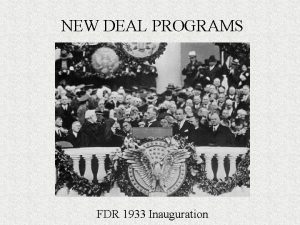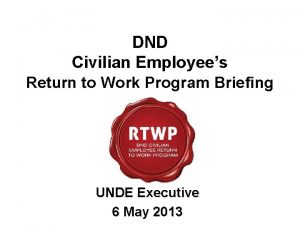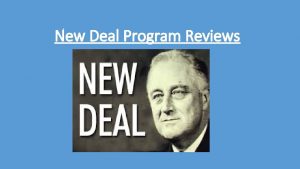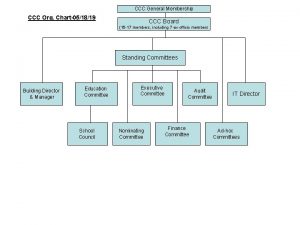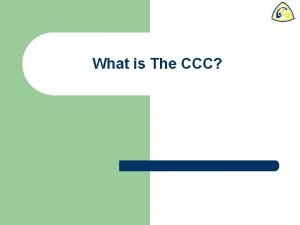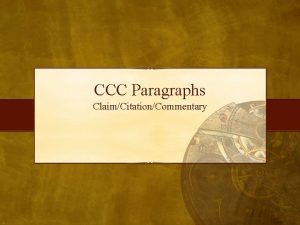Review of New Deal Programs CCC Civilian Conservation















- Slides: 15

Review of New Deal Programs

CCC: Civilian Conservation Corps 1. President Roosevelt hopes the program will “conserve our natural resources, create future national wealth and prove of moral and spiritual value” to the workers AND the rest of the country. He also hoped that the men would leave the CCC strong, rugged, and ready for reentrance into the ranks of industry equipped for the competitive fields of the industrial life of America.

CCC 2. FDR believed that in 1933 land men were two wasted resources. 3. Organized labor feared the CCC because union leaders wanted jobs to be filled by union members. 4. Only 37 days passed between FDR’s inauguration and the induction of the first enrollee. (Impressive!) 5. Logistical problems—most recruits lived in the East and most projects were in the West. How do you connect the two?

6. The public highly approved of the CCC program because it provided instant relief for struggling families and provided opportunities for educating and training unemployed young men. One Chicago judge pointed out the decreased crime rates after the program was implemented. 7. The CCC demonstrates the multiplier effect in “In communities close to the camps, local a positive way. The CCC stimulated the economy purchases averaging approximately $5, 000 with federal money. Workers made $30 a monthly staved off failure of many small (but $25 went home in a monthly check to their businesses. ” families. ) Since CCC workers had their basic needs of food and shelter met and their families received their paychecks, the remaining $5 would be spent in the communities in which they were employed. (One man’s spending becomes another man’s income. )

• 8. The CCC added education as a voluntary activity during non work hours and extended its applicants to include American Indians and unemployed LOCAL men. • 9. Ten specific accomplishments of the Corps included • 3, 470 fire towers erected • 97, 000 miles of fire roads built • 4, 235, 000 man-days devoted to fighting fires, • Three billion trees planted. • Erosion Control • Development of recreational facilities in national, state, county and metropolitan parks. • Protection of range for the Grazing Service • Protecting the natural habitats of wildlife • Stream improvement • Restocking of fish • Building small dams for water conservation. • Drainage • Emergency work during the flooding of the Ohio River in 1937.

The objective of the CCC was to recruit unemployed men forestry, erosion control, flood prevention, and parks development. The four agencies involved were: • U. S. Department of Labor- recruited men for 6 month enlistments • U. S. Department of War- provided army officers to operate 200 man camps • U. S. Departments of Interior and Agriculture- identified projects and supervised the work By the presidents deadline, 274, 375 men were working at 1, 300 camps. 10. Congress stopped funding the CCC. 11. Robert Fechner of Georgia was put in charge of the CCC 12. Despite the CCC’s popularity in Georgia, Eugene Talmadge felt that the New Deal programs were an intrusion into state government 13. Georgia failed to recruit eligible blacks until the Labor Department made threats; Georgia violated laws against racial discrimination by segregating camps and discouraging or preventing African Americans from enlisting.

CCC Projects taught lasting skills like: planting trees, constructing erosion dams, and running telephone lines. 14. The CCC specifically impacted Georgia by: • • • State parks (Pine Mountain, Indian Springs, Vogel…) Served as an honor guard for president while visiting GA Built lakes and ponds Cabins and lodges Preserved historical features (Chickamauga, Kennesaw Mt, Andersonville Constructed roads and trails Restoration of historical fortifications Chattahoochee National Forest Appalachian Trail Facilities in the Okefenokee Swamp Archaeological work at Ocumulgee Mounds

AAA: Agricultural Adjustment Act

AAA: Agricultural Adjustment Act 1. The purpose of the AAA was to balance supply and demand for farm commodities so that prices would support a decent purchasing power for farmers. 2. The program controlled the supplies of- corn, wheat, cotton, rice, peanuts, tobacco, and milk- by offering payments to farmers to leave fields fallow (NOT plant a portion of their land. ) 3. Most farmers participated because they needed the money; others had the attitude that “the government can’t tell me what to do. ” 4. The AAA helped revive hope in farm communities and it remained the basis for all farm programs for the next 70 years. 5. The AAA favored large landowners and ignored tenant farmers and sharecroppers. Over 100, 000 black farmers were forced off land due to the AAA’s policies. Only certain crops were eligible and no livestock producers were included.

AAA: Agricultural Adjustment Act 6. 40% of African Americans made their living as sharecroppers and tenant farmers. The AAA forced more than 100, 000 blacks off the land in 1933 and 1934. 7. Many black leaders also criticized FDR for not supporting the anti-lynching bill and a bill to abolish poll tax. 8. FDR feared that conservative southern Democrats would block his bills if he tried to fight them on race issues. 9. TWO positives FDR’s Administration took towards Civil Rights: -FDR’s administration did make gains in civil rights by appointing Mary Mc. Leod Bethune, a black educator, to the advisory committee of the National Youth Administration. Her leadership allowed many blacks to benefit from its work relief. -Harold Ickes, a strong supporter of civil rights had several blacks on his staff, poured federal funds into black schools and hospitals in the south.

REA: Rural Electrification Administration

REA: Rural Electrification Administration 1. The REA is a federal loan subsidy program that assisted groups of rural farms with building and running their own electrical distribution systems 2. By 1930, 90% of urban households & 10% of rural had electricity. 3. Small towns remained in the dark because electric service providers found it too expensive to invest in creating an electrical infrastructure in these areas where residents were stretched too far apart. 4. FDR paid four times as much for power to his home in Georgia than he did in his Hyde Park Community in New York. This bill shocked him. 5. FDR owned a farm and was a part-time resident in Warm Springs, Georgia 6. REA established 417 cooperatives to serve 288, 00 households, and raised the percentage of rural homes with electricity to 25%.

REA: Rural Electrification Administration 7. Five ways rural life was improved by electricity were: • • Lights Radio Refrigeration- including ice! Washing machine not powered by gasoline Electric pump instead of hand pump for water Iron Stoves Electric Range

SSA: Social Security Administration

1. The SSA was signed into law by FDR on August 14, 1935 2. The SSA established multiple government programs that helped provide economic security for millions of Americans. 3. Pay as you go – funded evenly by workers and employers. SSA tax is 12. 4% of a worker’s earnings- half is taken from employee pay checks and half is paid by the employer. 4. Talmadge opposed the SSA because he believed in a laissez-faire attitude toward governance, and felt the SSA was another step toward destruction of state government. 5. Eugene Talmadge blocked state legislators’ measures to establish the agency even though many Georgians supported SSA. Every US congressman and senator from Georgia voted for the SSA. 6. Critics noted that unemployment insurance excluded professions dominated by women and people of color. SSA: Social Security Administration
 New deal
New deal What is the main idea of this cartoon?
What is the main idea of this cartoon? Deal or no deal machine
Deal or no deal machine Rudolf vizental
Rudolf vizental Disadvantages of waterfall model in software engineering
Disadvantages of waterfall model in software engineering Military residency match
Military residency match Da form 7222 1
Da form 7222 1 Civilian benefits hroc navy mil
Civilian benefits hroc navy mil If a civilian employee condones
If a civilian employee condones Be not entangled with the cares of this world
Be not entangled with the cares of this world Civilian strategic leader program
Civilian strategic leader program Civilian dnd
Civilian dnd Sales deal review template
Sales deal review template The great depression vocabulary
The great depression vocabulary New deal alphabet soup
New deal alphabet soup New deal affects many groups
New deal affects many groups
